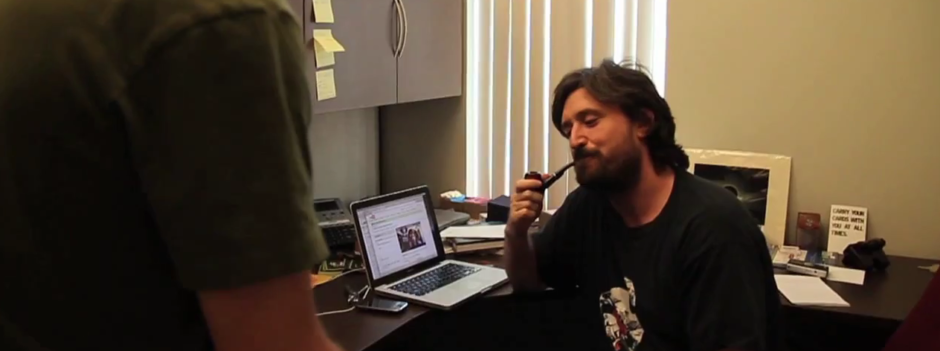About
Jeff Watson is an artist, designer, and Assistant Professor of Interactive Media and Games at the University of Southern California School of Cinematic Arts.
-
Category Archives: Blog
Spontaneous transmedia combustion: collaborative storytelling, Cooks Source, and the Talking Dead
Online collaborative storytelling is an idea that people seem to get excited about in waves. At the peak of a given wave, designers and observers rightly express confidence that wholly new and powerful kinds of storytelling are just around the … Continue reading
Posted in Blog
Tagged cooks source, facebook, jay bushman, the talking dead, transmedia
Comments Off on Spontaneous transmedia combustion: collaborative storytelling, Cooks Source, and the Talking Dead
Transmedia: New Platforms – The Games of Nonchalance
[This post originally appeared at In Media Res as a part of the Transmedia: New Platforms theme week.] This video is a trailer for “The Games of Nonchalance,” a four-part transmedia experience “woven into the fabric of San Francisco.” Participation … Continue reading
Posted in Blog
Tagged in media res, jeff hull, nonchalance, san francisco, transmedia
Comments Off on Transmedia: New Platforms – The Games of Nonchalance
Fandom Squared
My paper, “Fandom Squared,” was published this month in Transformative Works and Cultures. From the introduction: Being a fan has always been about more than just “voting” for a particular story world. Indeed, in contrast to the streamlined logics of … Continue reading
Posted in Blog
Tagged fandom, fannish production, fans, remix, transformative works and cultures, web 2.0
Comments Off on Fandom Squared
Super Mario Sidewalk Speedrun
Whoever plays such a speedrun knows the levels by heart it’s safe to say. A clear challenge in a game like this is that the frame doesn’t show you what’s a bit to the right until you’re close to it (danger). What’s nice about this piece is that it actualizes the expert player’s memorized map of these levels – laid out on a sidewalk. Continue reading
Posted in Blog
Tagged andreas heikaus, augmented reality, nintendo, peter brinson, speedruns, super mario bros
Comments Off on Super Mario Sidewalk Speedrun
ARGFest Panel: City Gaming & Public Art
ARGFest 2010 is just around the corner, and I’m lucky enough to attending as a panelist. I’ll be taking part in a discussion with Anne Dennington, Carl DiSalvo, and Sara Thacher titled, “TransGenre: City Gaming & Public Art.” Continue reading
Posted in Blog
Tagged anne dennington, arg, argfest, atlanta, carl disalvo, nonchalance, panel discussion, peggy weil, sara thacher
Comments Off on ARGFest Panel: City Gaming & Public Art
IBM supercomputer “Watson” to appear on Jeopardy
…just don’t count on him to open the pod bay doors. Continue reading
Posted in Blog
Tagged artificial intelligence, game shows, jeopardy, supercomputers, watson
Comments Off on IBM supercomputer “Watson” to appear on Jeopardy
Incredible archive of 19th century scientific illustrations from the Challenger expedition
The Challenger expedition was an ambitious scientific mission that sought to catalogue the geology and biology of the world’s oceans. Among other achievements, the expedition managed to scoop up bizarre life forms from the deepest parts of the ocean, including … Continue reading
Posted in Blog
Tagged adventure, challenger deep, discovery, hms challenger, oceanography, science
Comments Off on Incredible archive of 19th century scientific illustrations from the Challenger expedition
No File: Brown – an interactive locative experience
We will be presenting No File: Brown, an interactive locative experience, at the ELO.AI conference at Brown University in Providence, Rhode Island from May 3 to 6, 2010. Continue reading
Posted in Blog
Comments Off on No File: Brown – an interactive locative experience
Another City for Another Life: the unforeseen games of the city of the future
ARGs, pervasive games, and location-based social games echo and reiterate a range of earlier experiments in ambient and locative art. Graffiti, sticker art, mail art, and other kinds of analog methods for creating distributed narratives paved the way for the kinds of practices that are today exploding in number and purpose thanks to ubiquitous computing and the real-time web. Lettrism and Situationism redefined urban space as a canvas for experimentation, play, and collaborative production. Continue reading
Posted in Blog
Tagged constant nieuwenhuys, lettrism, locative media, pervasive games, situationism, urban space
1 Comment
Designing interactions in the flow: tagging books at Bibliotheek Haarlem Oost
Nina K. Simon’s excellent paper, “Going Analog: Translating Virtual Learnings into Real Institutional Change,” describes how designers can approach integrating new user behaviors into existing ones — and why it’s often essential to do so. Continue reading
Posted in Blog
Tagged design, experience-design, libraries, museums, netherlands, nina k. simon, tagging
4 Comments
